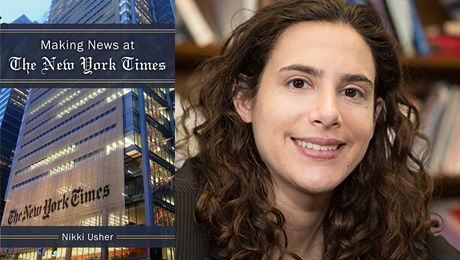By Julyssa Lopez
In “Making News at the New York Times,” assistant professor Nikki Usher goes where few scholars have gone before to take a behind-the-scenes look at one of the nation’s most prestigious newspapers. Dr. Usher was allowed access into the publication’s changing newsroom, where she spent five months conducting research to get to the root of how news is made in the digital age.
The book details Dr. Usher’s time observing meetings, following journalists, conducting dozens and dozens of interviews and listening in on daily staff conversations. Dr. Usher spoke with George Washington Today about the process of putting the book together, the inner workings of the paper and where the broader media landscape is heading in the future.
Q: Your book examines how news is made at the New York Times, but you've also done research on news production at other organizations, including the BBC, Al Jazeera and NPR. What got you interested in “newsroom hacking”?
A: I've gone across the country and the world doing research on news organizations going through change. I've been to places as diverse as the Fort Worth Star Telegram to the Guardian to the New York Times. I think a better term for what I work on is the study of news production. What this means is that I look at how things get made—the patterns, processes and decisions that lead up to the creation of news—as applied to the digital environment particularly. I’m not really sure that I would call this newsroom hacking, at least not yet, as nothing specific is being recombined into new, unique and novel situations.
Q: Did you find major differences between the New York Times and other media organizations you've studied?
A: The New York Times is both a case of one and emblematic of the newspaper industry. It is at once like many other newspapers struggling to become a digital-first newspaper and to overcome a difficult business environment for the survival of news. But the New York Times journalists just have so much tremendous faith in the newspaper as an institution—its permanence, its importance and its dedication to producing quality journalism.
Q: There has been a lot of speculation about how the digital age has (or hasn't) transformed media today. What were some of your observations about how the New York Times has reacted to and embraced emerging technology?
A: The New York Times has done some great things to embrace technology—for instance, building a robust website, adding incredible interactive graphics and increasing the importance of multimedia to the newsroom. At the same time, battles over how to do everything from social media to web videos are still being fought and remain unresolved.
Q: The New York Times made headlines recently when editor Jill Abramson was fired. What were your observations of Ms. Abramson while you were conducting your research, and what was your reaction to her dismissal?
A: Jill is an amazing leader and, from my interactions, an amazing person. She loves the New York Times as an institution—its power and its promise. I saw her lead firmly and serve as an example. The gossip and rumors that surrounded her firing make the New York Times simply look petty and bad.
Q: What are some of the most surprising things you learned throughout the course of putting your book together? What do some of your observations about the New York Times reveal about the larger media landscape today?
A: Even at this tremendous institution, there are still so many unresolved opportunities of where to go and what to do next. The larger media landscape needs some serious strategy about how to move forward from content to distribution to audience engagement to production efficiency. Of course, that's part of why I do my research—to be a third party to comment on what goes on and provide insight to journalists about the way forward.


